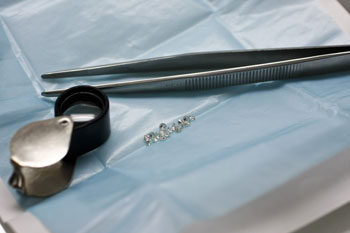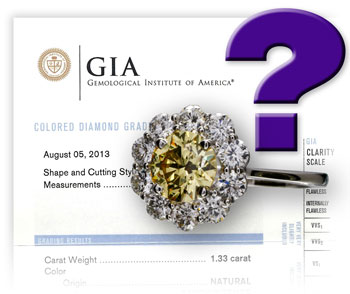Synthetics in the Mix
Synthesized diamonds are being slipped in with naturals. Synthetic diamonds are worth far less but, passed off as mined diamonds, they fetch a higher price.
It's a problem even the diamond industry is worried about, and if the industry is worried, consumers and insurers should also be.
The issue is fraud—and who's being cheated.
Lab-made diamonds have been around for quite some time. As the technology for synthesizing diamond improves, more lab-made stones are making their way to the market. As JII has reported in the past, not all of them are disclosed as synthetic.
Recently there's been a big jump in fraud attempts. Several scams are afoot, at different places along the selling chain. Here are some examples of what's going on.
1. Loose Diamonds
In the normal course of trade, diamond brokers and dealers sell faceted and polished gems in parcels to buyers who export them around the world. A parcel might contain dozens of diamonds or even several hundred diamonds, depending on the order.
Further down the trading line, a jeweler might order a small parcel of diamonds, often of a specific size. The parcel shown above has 18 diamonds, each weighing .06 caret. Such small diamonds, known as melee, might be used to enhance the setting of a larger central diamond. The buyer is told, or he assumes, that all the diamonds in the parcel are natural.
Recently, lab examinations have found that a number of these parcels contained synthetic diamonds mixed in with naturals. Sometimes 50% of the contents are synthetic. In one parcel from India, all 19 stones were found to be synthetic.
It's not common practice for wholesale buyers to have each diamond in a parcel lab-appraised, as the cost would be prohibitive, especially for very small stones. Parcels salted with synthetics mean a serious loss for the buyer, since lab-grown diamonds sell for considerably less than natural diamonds.
An honest dealer would like to trade only with trusted sources, but it isn't possible to trace the provenance of each stone. Generally buyers take the supplier's word that the gems are natural—at least they have until now.
It isn't known how many contaminated batches may have made their way into the marketplace without the stones being examined. Or, if stones in the batch are found to be synthetic, the buyer may not want to take the loss, so he moves them on as naturals. If the subterfuge goes undetected, all purchasers along the way will be victimized, including the ultimate jewelry consumer.
2. Set in jewelry
Other reports involve the sale of jewelry set with diamonds — diamonds that are said to be natural but turn out to be synthetic. These early reports are coming out of China, and the US is China's biggest consumer. Jewelry is a worldwide business, with both gems and finished jewelry from various businesses fluidly crossing political boundaries.
Suppose a company receives an order for 300 diamond straight line bracelets. The broker must locate stones from various suppliers, each of which may have to put together parcels from many small cutters. In Surat, India, for example, where about 90 per cent (by value) of the world's diamonds are cut, there are more than 350,000 gem cutters in 2,500 factories. There's no way to track the movements of each small stone that makes its way into a piece of jewelry.
This could soon mean problems for insurers. For example, a diamond straight line bracelet is insured as having all natural diamonds. Later examination of the bracelet reveals that some of the stones are synthetic. And it turns out the bracelet had been cleaned. Had synthetic stones been substituted by the jeweler doing the cleaning? If so, that would be theft, and would be covered under the Homeowner's/jewelry policy. But perhaps the synthetic diamonds were there to begin with. Neither the consumer nor the insurer would know. Nor, in all likelihood, would the retailer, and so on up the selling chain.
As we've discussed in previous issues, some diamond-growing labs are honest companies, advertising their products as alternatives to natural diamond and pricing their goods accordingly. The problem is the proliferation of synthetic diamond producers and dishonest gem dealers using the anonymity of the market routes to mingle synthetic with natural diamond and make a killing.
3. Certified??
Rapaport, a respected publication in the gem industry, reports a more brazen, and far more insidious, scam: companies that buy GIA grading reports originally done for natural diamonds, and then have synthetic diamonds cut to match the reports. Rapaport said that in some cases the synthetic stones are even laser-inscribed with the GIA logo and report number.
This is particularly devious because the buyer who checks the report number on the GIA website will find everything a match—carat weight, color, clarity, etc. GIA is a trusted lab, so the buyer is reassured about the quality of her purchase. There would be no reason to second-guess a GIA report.
Detection & disclosure
We usually have easy-to-follow recommendations for insurers to avoid being victimized by fraud. However, the technology of diamond synthesis is advancing so quickly that detection of synthetics has a hard time catching up, and reasonable priced equipment simply doesn't yet exist for today's appraisers.
Curtailing fraud depends on disclosure all along the trading chain—laboratory, distributor, jewelry manufacturer, retailer, appraiser, consumer. And disclosure often depends on the ability to distinguish synthetic diamonds from naturals.
Our next issue will discuss both these issues, including new tools for detecting synthetic diamonds, a renewed focus on ethics of disclosure in the gem industry, and steps insurers can take to avoid being taken in.
FOR AGENTS & UNDERWRITERS
There is no easy solution to the problem of synthetic diamonds being sold as natural. More research and better tools are needed.
For now, the insurer's best protection against fraud is a detailed appraisal from a trained gemologist appraiser.
For all quality jewelry, request a JISO 78/79 appraisal that gives a detailed description of the jewelry, both stones and setting, and gives a valuation. This appraisal is prepared by a trained gemologist (GG, FGA+, or equivalent), preferably one who has additional training in appraising for insurance. One course offering such training is the Certified Insurance Appraiser™ course.
Despite the scam involving fraudulent GIA certificates, a diamond report from a reliable lab is still good practice. We recommend the following highly respected labs and suggest that you use these links to verify reports you receive.
GIA Report Check
AGS Report Verification
GCAL Certificate Search
If you have any reason to suspect a diamond report is bogus, it may be worthwhile to consult a jewelry insurance expert.
FOR ADJUSTERS
With diamonds, the price difference between natural and synthetic is far greater than with most other stones. Mistaking a synthetic diamond for a natural could mean an overpayment of tens of thousands of dollars.
This is where the sales receipt becomes important. If there is a huge difference between the purchase price and the appraisal valuation, it's a good bet that the gem is not natural diamond but a stone of lesser value—synthetic diamond, moissanite or even CZ, cubic zirconia.
The diamond industry is struggling to develop dependable and cost-effective solutions for detecting synthetics. For larger diamonds that are damaged, it is practical to send them to a large lab such as GIA, which has the latest equipment for identifying gems.
Read carefully all documents on file. Do not assume that a gem is natural unless that is specifically stated on the appraisal.
Comb the documents for words meaning synthetic, such as created, grown, lab-made, man-made, lab-grown, and cultured diamond.
Always have the damaged jewelry examined in a gem lab by a trained gemologist (GG, FGA+, or equivalent), preferably one who has additional training in appraising for insurance. One course offering such training is the Certified Insurance Appraiser™ course.
©2000-2025, JCRS Inland Marine Solutions, Inc. All Rights Reserved. www.jcrs.com




